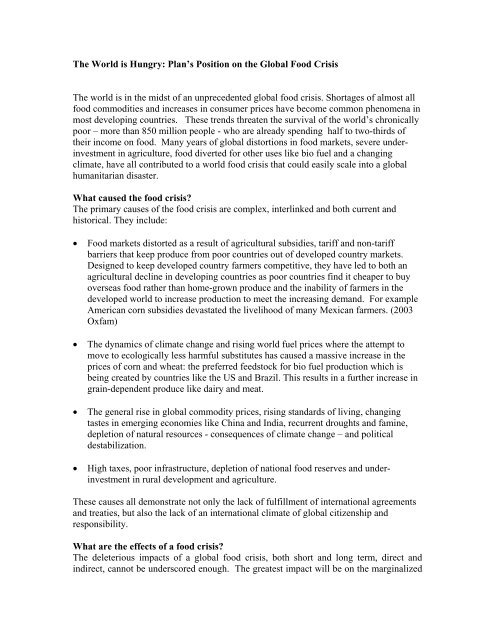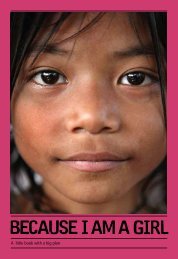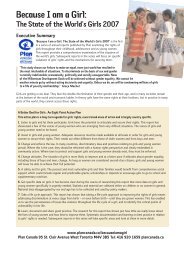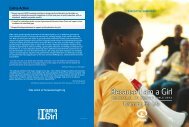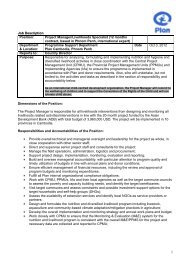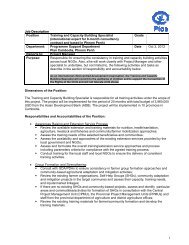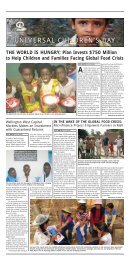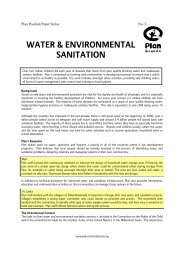executive summary - Plan Canada
executive summary - Plan Canada
executive summary - Plan Canada
You also want an ePaper? Increase the reach of your titles
YUMPU automatically turns print PDFs into web optimized ePapers that Google loves.
The World is Hungry: <strong>Plan</strong>’s Position on the Global Food CrisisThe world is in the midst of an unprecedented global food crisis. Shortages of almost allfood commodities and increases in consumer prices have become common phenomena inmost developing countries. These trends threaten the survival of the world’s chronicallypoor – more than 850 million people - who are already spending half to two-thirds oftheir income on food. Many years of global distortions in food markets, severe underinvestmentin agriculture, food diverted for other uses like bio fuel and a changingclimate, have all contributed to a world food crisis that could easily scale into a globalhumanitarian disaster.What caused the food crisis?The primary causes of the food crisis are complex, interlinked and both current andhistorical. They include:• Food markets distorted as a result of agricultural subsidies, tariff and non-tariffbarriers that keep produce from poor countries out of developed country markets.Designed to keep developed country farmers competitive, they have led to both anagricultural decline in developing countries as poor countries find it cheaper to buyoverseas food rather than home-grown produce and the inability of farmers in thedeveloped world to increase production to meet the increasing demand. For exampleAmerican corn subsidies devastated the livelihood of many Mexican farmers. (2003Oxfam)• The dynamics of climate change and rising world fuel prices where the attempt tomove to ecologically less harmful substitutes has caused a massive increase in theprices of corn and wheat: the preferred feedstock for bio fuel production which isbeing created by countries like the US and Brazil. This results in a further increase ingrain-dependent produce like dairy and meat.• The general rise in global commodity prices, rising standards of living, changingtastes in emerging economies like China and India, recurrent droughts and famine,depletion of natural resources - consequences of climate change – and politicaldestabilization.• High taxes, poor infrastructure, depletion of national food reserves and underinvestmentin rural development and agriculture.These causes all demonstrate not only the lack of fulfillment of international agreementsand treaties, but also the lack of an international climate of global citizenship andresponsibility.What are the effects of a food crisis?The deleterious impacts of a global food crisis, both short and long term, direct andindirect, cannot be underscored enough. The greatest impact will be on the marginalized
communities and populations within developing countries. The types of food items,environment, and range of people affected, vary between countries. For example,dramatic increases in staple food prices have led to riots and protests in Haiti, Cameroon,Guinea, Egypt, India and Senegal. In semi-arid areas, prolonged droughts areincreasingly common as is migration to urban areas where unemployment rates arealready high. The most affected continue to be the urban and rural poor, pastoralists/agropastoralists,marginal agricultural farm households and already food-insecurepopulations.The effects on children and their families in these regions are particularly grave. Sincethe ripple effects would reach other areas of development, a global food crisis coulderase, and even reverse the accomplishments made toward achieving all of the eightMillennium Development Goals (MDGs) and the attendant targets set by the world’snations. Children will face increased poverty and malnutrition. In education, schoolfeeding programs have been critical to enabling many children to access schooling. Forexample in Malawi, <strong>Plan</strong> distributes food as part of an integrated school feeding project.The project distributes food to primary school children in the food insecure areas ofMulanje and Kasungu. The project targets 54 schools and will reach approximately70,000 school children. In addition to food distribution, the project builds the capacity ofchildren and their families around safe water usage, health and sanitation, as well as fruitand vegetable production. Health would be impacted both by the effects of malnutrition,but also high food prices would force families to do without other essentials like medicalcare. Their mothers will be at greater risk of maternal death, and their siblings face higherinfant mortality.Men and women, and boys and girls are affected differently by the global food crisis,both as producers of food and as consumers. Rising food prices have increased thevulnerability of women and girls; even before the food crisis emerged, 7 out of 10 of theworld’s hungry were women and girls. Indeed, women and girls are more vulnerable topoverty and the effects of the crisis because of existing gender-based discrimination,which leaves them with less access to property, credit, education, and agricultural inputsincluding fertilizer and training and support services. Furthermore, women and girls areusually the ones directly responsible for the household welfare, and therefore bearincreased responsibility to ensure the household’s food security.A food crisis threatens the most fundamental right of humans, namely the right toadequate food. Without the fulfillment of this basic right, all other rights becomeineffectual and meaningless. When families have reduced disposable income and lackadequate food, children are at increased risk of exploitation including ending up workingin hazardous conditions, such as the sex trade. Child protection programs need to be inplace to ensure children’s rights are not violated. The food crisis ultimately threatens thevery foundations of the rights-based approach, which is the dominant developmentpractice of many global actors including the United Nations and international NGOs suchas <strong>Plan</strong> International.What is the current global response?
The steps being taken by various duty-bearers are wide–ranging. The actions ofgovernments across the world range from monitoring, to short-term emergency food aidappeals, food deliveries and price controls, further to planning for long-term sustainablefood security situations. <strong>Canada</strong> has allocated $230 million in support of food aidprogramming this fiscal year, which is a $50 million increase over last year to become thesecond largest donor to the World Food Program. <strong>Canada</strong> is also promoting the growth oflocal and regional markets in developing countries by “untying” some of its procurementterms.Canadian funding for food aid is distributed through two primary channels: the WorldFood Program (WFP) and the Canadian Food Grains Bank (CFGB). As well, Canadianfunding for food security and economic development is channelled through its bi-lateralmechanism. There are a number of key multi-lateral organisations such as the WorldFood Program (WFP), the World Bank (WB), International Monetary Fund (IMF), Foodand Agriculture Organisation (FAO), International Fund for Agricultural Development(IFAD) and the United Nations (UN) who are addressing the crisis through bothshort-term intervention: food aid, and long-term solutions: reviewing the trade policies,investment in agriculture, pricing strategies, social safety net programs, and alternativesolutions for fuel crisis. There has been much criticism that the band-aid efforts of theworld community do not address the causal factors of chronic food shortages. Thepresent crisis therefore, offers an opportunity for <strong>Canada</strong> to play a much bigger role inpressing for global efforts that address both the short and the long-term effect of foodshortage.There is also a role for civil society in abating the food crisis. Non-governmentalorganizations in both the developed and developing countries, particularly thosecommitted to children, are duty-bearers for the communities they serve.There is a need to prioritize and address gender inequality as a fundamental determinantto the food crisis. The food price crisis requires economic and agricultural policies thatintentionally address the gender implications of the crisis. <strong>Plan</strong> is committed to ensuringthat the policy and programmatic responses to the food price crisis are not gender blind.Strategic investments are required in female agricultural workers to increase women’saccess to resources, technologies and markets of agricultural production. Food aidtargeted to women benefits the whole household, and therefore better strategies arerequired that ensure women are central actors in food aid distribution.<strong>Plan</strong> practices a child-centered community development approach, addressing issues thatprevent children from reaching their full potential. Through fundraising, advocacy andprograms, <strong>Plan</strong> consistently works with the most marginalized and hard-to-reachpopulations, adopting a long-term partnership approach where development initiatives aremaintained for ten years or more. <strong>Plan</strong> works in 49 developing countries implementingvarious short-, mid- and long-term interventions that have a direct impact on the foodcrisis situation. These include: direct nutritional supplementation, promotion of foodsecurity through strengthening the agriculture sector, rights-based social protectioninterventions for children, strengthening microfinance institutions, enhancing
President’s MessageMARK LAGARDELLSSA PRESIDENTWhere have you’ve been,and more importantly, whereare you going. Since my lastarticle, many changes havetaken place and, in my opinion,many more are coming.Since last year, Louisianahas voted in a new Governorand with that came a newFire Marshal which directlyimpacts our industry. I havepersonally talked with “ButchBrowning” as have the majorityof you. He has beento all of our regional meetingsthus farand comesacross as avery passionateperson. Ithink we canall agree hehas been anasset to bothhis office andour industry.He is astrong proponentof Life Safety andwill push for the legislationto make it safer. In the nearfuture, I believe you will seesuch legislation as mandatorysprinkler systems in newhomes and a change in theresidential household smokedetector code.Last month a new Presidentwas put into office. With thisnew President will comenew challenges. Our nationaland local lobbyists are keepinga close eye on new legislation.Look for changes inLife Safety and be ready forit. We are presently consideringdifferent ways to channelmonies into our stateSome Dates to Remember:2009 AIREF Golf Classic March 31 Las VegasISC West April 1-3 Las VegasAFAA Convention Savannah April 14-16 Savannah, GANBFAA Capital Hill Day April 28-29 Washington DCNBFAA ESX June 22-26 Baltimore, MDLLSSA Trade Show November 18-19 Kenner, Laand industries.I’m sure many of you areglad that 2008 is behind us.At the NBFAA Summit lastmonth, I was able to talkwith other security companiesaround the nation.Companies who offer morethan one service seem to befaring better than those thatdo security only. It has beenmy experience that Louisianatends to follow nine totwelve months behind thenational trends. Also at thesummit, the “summer sales”was brought up once again.For those that are not familiarwith “summer sales” inLouisiana, it was because ithappened in Baton Rougeand handled swiftly by ourFire Marshal’s Office. “SummerSales” is a program thatoriginates in Utah. Salesmentarget neighborhoodsin hopes of selling to yourcustomer, taking out yoursystem and monitoring thesystem. By the time you aremade aware of this, they’regone. This has been a problemthroughout the nation.At the last chartered statemeeting in Nashville, an adhoccommittee was to beformed in order to study thisincreasing problem. At thispast chartered state meeting,National announcedthat it has dropped its adhoccommittee and that this complaintshould be handled atthe state level. Once again,Louisiana leads the packwith its wisdom and procedure.Scot and I were theonly two to vote against anadhoc committee for thosevery reasons. For those ofus that are using our NBFAAliability insurance, we knowthe savings we are receiving.For those that are not,call and get a free quote. Youwon’t be sorry.I will keep you postedthroughout the year. If thereis an issue that you needlooking into, please notifyus. We are most willing tohelp our members in anyway we can.www.cmsn.comJim PlessBusiness Development Representativejimpless@cmsn.com / 866-647-06641341 Capital Circle, Suite 1 / Marietta, GA 30067770-914-9397 (fax)Page 2 / LLSSA FIRST QUARTER 2009
3) Put food security on the agenda: At all inter-governmental forums and meetings,governments should ensure that food security is on the agenda and that concreteactions are both committed to and implemented.4) Increase aid to agriculture sector – All governments of developed nations need togive well-funded and focused support to developing countries to increaseinvestment in research and development for small-holder agriculturaldiversification, and support farmers both in livelihood as well as food productionfor household consumption and local markets.Civil Society5) Focus on child protection within all programming addressing the global foodcrisis. Within this crisis the risks to children increase. These include childrenbeing forced into working in the worst forms of child labour, work in the sex tradeand separation from their families. <strong>Plan</strong> calls for an increase in child protectioninitiatives within all programs to address this crisis.6) Promoting alternative livelihoods. Families dependant solely upon farming willbe forced into poverty during harvest failure. Programs should be developed thatwill train and educate farmers in alternative employment skills.7) Increased partnership with governments, private sector and communities.Civil society cannot achieve sustainable results working in isolation. Programmingshould include the active input and involvement of other duty bearers such asgovernments, corporations and communities.8) Apply a gender equality lens when designing programmatic interventions:seemingly gender-neutral interventions may have a discriminatory effect on girlsand women if their current and historic disadvantages are not considered, and theircritical role in food production is not taken into account.


